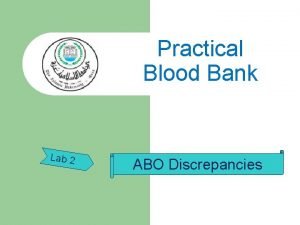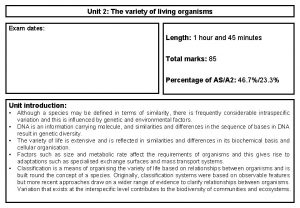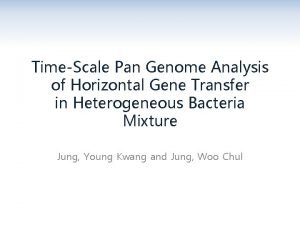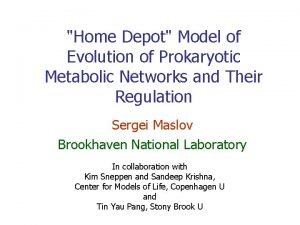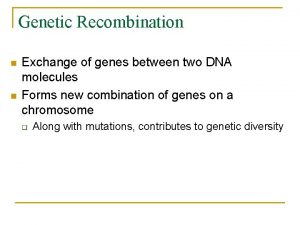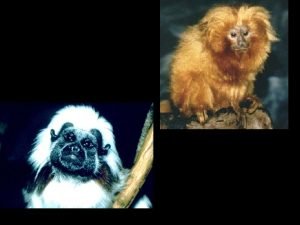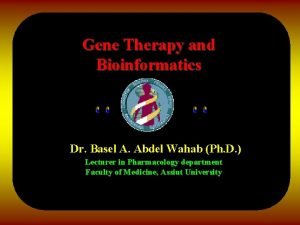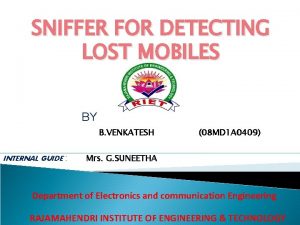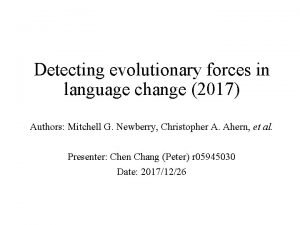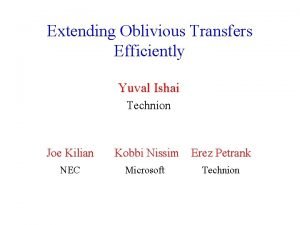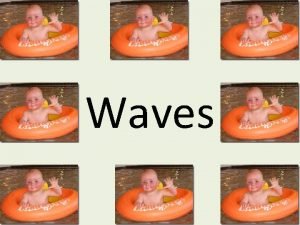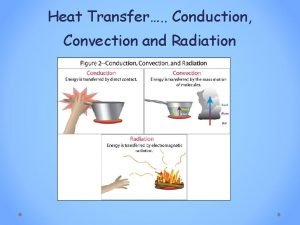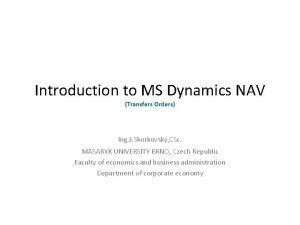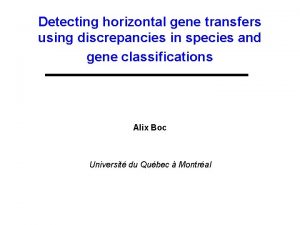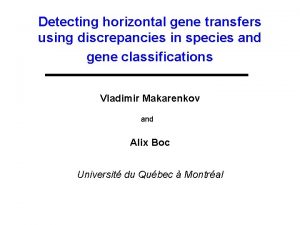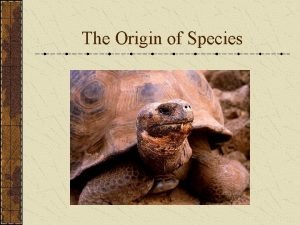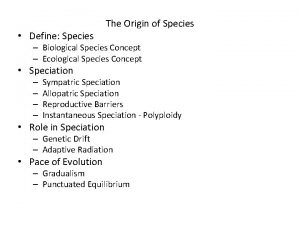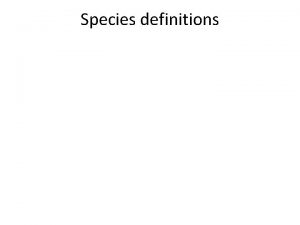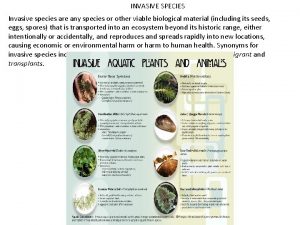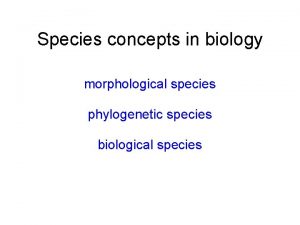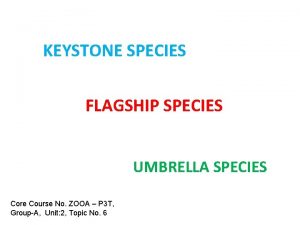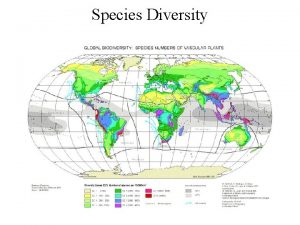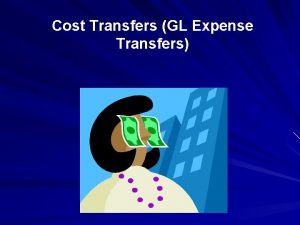Detecting horizontal gene transfers using discrepancies in species
















































- Slides: 48

Detecting horizontal gene transfers using discrepancies in species and gene classifications Vladimir Makarenkov and Alix Boc Université du Québec à Montréal

Presentation summary • Network models in phylogenetic analysis • What is a horizontal gene transfer (HGT)? • Description of the new method • Examples of application • Future works • T-REX software

Inferring phylogenetic trees Four main approaches: • Distance-based methods • UPGMA by Michener and Sokal (1957) • ADDTREE by Sattath et Tversky (1977) • Neighbor-joining (NJ) by Saitou and Nei (1988) • UNJ and Bio. NJ methods by Gascuel (1997) • Fitch by Felsenstein (1997) • Weighted least-squares MW by Makarenkov and Leclerc (1999) • Maximum Parsimony (Camin and Sokal 1965; Farris 1970; Fitch 1971) • Maximum Likelihood (Felsenstein 1981) • Bayesian approach (Rannala and Yang 1996; Huelsenbeck and Ronquist 2001)

Phylogenetic mechanisms requiring a network representation • Horizontal gene transfer (i. e. lateral gene transfer) • Hybridization • Homoplasy and gene convergence • Gene duplication and gene loss

Software for building phylogenetic networks • Splits. Tree, Huson (1998) • T-Rex, Makarenkov (2001) • Neighbor. Net, Bryant and Moulton (2002)

Methods for detecting horizontal gene transfers • Hein (1990) and Hein et al. (1995, 1996) • Haseler and Churchill (1993) • Page (1994); Page and Charleston (1998) • Hallet and Lagergren (2001) • Mirkin, Fenner, Galperin and Koonin (2003) • V’yugin, Gelfand Lyubetsky (2003) • Boc and Makarenkov (2003); Makarenkov, Boc and Diallo (2004)

Thee types of horizontal gene transfer

Partial gene transfer versus complete transfer (a) (b)

The new model Basic ideas: 1) Reconcile the species and gene phylogenetic trees using either a topological (Robinson and Foulds topological distance) or a metric (least -squares) criterion 2) Incorporate necessary biological rules into the mathematical model 3) Maintain the algorithmic time complexity polynomial

Partial gene transfer. Incorporating biological rules. Situations when a new HGT branch (a, b) evolutionary can affect distance between species i and j, and cannot affect the distance between i 1 and j. the

Partial gene transfer. Incorporating biological rules (2). Three cases when the evolutionary distance between the species i and j is not affected by addition of a new HGT branch (a, b)

Partial gene transfer. Incorporating biological rules (3). No HGTs can be considered when affected branches are located on the same lineage

Partial gene transfer. Incorporating biological rules (4). No HGT can be considered when two HGTs affecting a pair of lineages intersect as shown

Partial gene transfer. Incorporating biological rules (5). • Cases (a) and (b): path between the leaves i and j is allowed to go through both HGT branches (a, b) and (a 1, b 1). • Cases (c) and (d) : path between the leaves i and j is not allowed to go through both HGT branches (a, b) and (a 1, b 1).

Algorithmic scheme Step 1. Construction of the species and gene phylogenies T and T 1 • Let X be a set of n taxa (i. e. species or objects). • Infer a binary species phylogenetic tree T from the sequence or distance data (using 16 S or 23 S r. RNAs or other genes that are not supposed to be transferred horizontally). This tree has 2 n-3 branches and n leaves. • T is explicitly rooted. • Consider the same n taxa from X. Infer a binary gene phylogenetic tree T 1.

Algorithmic scheme Step 2. LS mapping of the gene tree into the species tree • If the topologies of T and T 1 are identical, no horizontal gene transfers can be indicated. • If the topologies of T and T 1 are different, it may be the result of horizontal gene transfers. The gene tree T 1 can be mapped into the species tree T by fitting by least squares the branch lengths of T to the pairwise distances in T 1 (Bryant and Wadell 1998; Makarenkov and Leclerc 1999). • Each pair of branches of the species tree T is tested for the possibility of an HGT. All branch lengths in T are reassessed according to the pairwise distance in T 1.

Algorithmic scheme Step 3. Unique and Multiple gene transfer scenarios Once all pairs of branches in T are tested, an ordered list L of all possible HGT connections between pairs of branches in T can be established. Each entry of L is associated with a gain in fit obtained for a particular HGT. The researchers can then either: 1. Choose the best (most probable HGTs) from this list taking into account the HGT order in L as well as any useful knowledge about the data at hand (Multiple Scenario). 2. Or, add to the species tree T the best second (according to the LS criterion), third, and so forth HGT branches in the way that the computation of each new HGT branch is done taking into account all previously added HGTs (Unique Scenario).

Optimization problem : Least-squares The least-squares loss function to be minimized with an unknown length l of the HGT branch (a, b): Q(ab, l) = + min d(i, j) - the minimum path-length distance between the leaves (i. e. taxa) i and j in the tree T (i, j) - the given dissimilarity value between i and j dist(i, j) = d(i, j) – Min { d(i, a) + d(j, b); d(j, a) + d(i, b) }

Complete gene transfer 1 3 2 Species Tree Upcoming HGT 1 Species Tree + HGT 1 Upcoming HGT 2 Species Tree + HGT 2 Upcoming HGT 3 Species Tree + HGT 3 (Gene Tree)

Optimization problem : Robinson and Foulds topological distance The topological distance of Robinson and Foulds (1981) between two phylogenetic trees is equal to the minimum number of elementary operations consisting of merging or splitting vertices necessary to transform one tree into another.

Robinson and Foulds topological distance Robinson and Foulds distance between T and T 1 is 2. The HGT minimizing the Robinson and Foulds topological distance between the species and gene phylogenetic trees can be considered as the best candidate to reconcile the species and gene phylogenies.

HGT detection algorithm : Complete transfer • Test all connections between pairs of branches in the species tree T. • Compute the RF distance or LS coefficient for each connexion. In the case of LS optimization, the length of each edge of the species tree is reassessed according to the gene distance matrix. • The best HGT found (i. e. HGT minimizing the optimization criterion) is added to the species tree transforming it into another phylogenetic tree. • Run the algorithm while the transformed species tree is topologically different from the gene tree. • Time complexity: O(kn 4) for k HGTs and n species.

Application example 1 Horizontal transfer of the Rubisco Large subunit gene Delwiche, C. F. , and J. D. Palmer. 1996. Rampant Horizontal Transfer and Duplication of Rubisco Genes in Eubacteria and Plastids. Mol. Biol. Evol. 13: 873 -882.

rbc. L Gene Phylogeny

Delwiche and Palmer (1996) - hypotheses of HGTs 1 - Cyanobacteria → γ-Proteobacteria 2 - α-Proteobacteria → Red and brown algae 3 - γ-Proteobacteria → α-Proteobacteria 4 - γ-Proteobacteria → β-Proteobacteria

HGTs of the rbc. L gene

HGTs of the rbc. L gene - comparison Hypotheses by Delwiche and Palmer (1996) 1 - Cyanobacteria → γ-Proteobacteria 2 - α-Proteobacteria → Red and brown algae 3 - γ-Proteobacteria → α-Proteobacteria 4 - γ-Proteobacteria → β-Proteobacteria Solution 1. α-Proteobacteria → Red and brown algae 2. a-Proteobacteria → β-Proteobacteria 3. b-Proteobacteria → γ-Proteobacteria 4. b -Proteobacteria → a-Proteobacteria 5. γ-Proteobacteria → β-Proteobacteria 6. γ-Proteobacteria → Cyanobacteria 7. γ-Proteobacteria → β-Proteobacteria

Application example 2 Horizontal transfers of the protein rpl 12 e Data taken from: Matte-Tailliez O. , Brochier C. , Forterre P. & Philippe H. Archaeal phylogeny based on ribosomal proteins. (2002). Mol. Biol. Evol. 19, 631 -639.

Rpl 12 e HGTs Assumed HGTs of the rpl 12 e gene involved the clusters of Crenarchaeota and Thermoplasmatales (Matte-Tailliez, 2004) Species tree Rpl 12 e gene tree

Reconciliation scenario

Future developments • Maximum Likelihood model • Maximum Parsimony model • Validation methods (bootstrapping) • Decreasing the running time

Bibliography • Boc, A. and Makarenkov, V. (2003), New Efficient Algorithm for Detection of Horizontal Gene Transfer Events, Algorithms in Bioinformatics, G. Benson and R. Page (Eds. ), 3 rd Workshop on Algorithms in Bioinformatics, Springer-Verlag, pp. 190 -201. • Delwiche, C. F. , and J. D. Palmer (1996). Rampant Horizontal Transfer and Duplication of Rubisco Genes in Eubacteria and Plastids. Mol. Biol. Evol. 13: 873 -882. • Makarenkov, V. (2001), T-Rex: reconstructing and visualizing phylogenetic trees and reticulation networks. Bioinformatics, 17, 664 -668. • Makarenkov, V. , Boc, A. and Diallo A. B. (2004), Representing Lateral gene transfer in species classification. Unique scenario, IFCS’ 2004 proceedings, Chicago. • Matte-Tailliez O. , Brochier C. , Forterre P. & Philippe H. (2002). Archaeal phylogeny based on ribosomal proteins. Mol. Biol. Evol. 19, 631 -639. • Robinson, D. R. and Foulds L. R. (1981), Comparison of phylogenetic trees, Mathematical Biosciences 53, 131 -147.

T-REX — Tree and Reticulogram Reconstruction 1 Downloadable from http: //www. info. uqam. ca/~makarenv/trex. html Authors: Vladimir Makarenkov Versions: Windows 9 x/NT/2000/XP and Macintosh With contributions from A. Boc, P. Casgrain, A. B. Diallo, O. Gascuel, A. Guénoche, P. -A. Landry, F. -J. Lapointe, B. Leclerc, and P. Legendre. ____ Makarenkov, V. 2001. T-REX: reconstructing and visualizing phylogenetic trees and reticulation networks. Bioinformatics 17: 664 -668. 1

Methods available • Six methods for inferring phylogenetic trees from distance data • Three methods for reconstructing reticulograms (phylogenetic networks)

Methods available • Four methods for inferring phylogenetic trees from incomplete distance data • Visualization and interactive manipulation of phylogenetic trees and networks

Phylogenetic tree inferring methods • ADDTREE by Sattath et Tversky (1977) • Neighbor-joining (NJ) by Saitou and Nei (1988) • UNJ and Bio. NJ methods by Gascuel (1997) • Circular order reconstruction by Makarenkov and Leclerc (1997) • Weighted least-squares MW by Makarenkov and Leclerc (1999)

Tree reconstruction with missing data • Ultrametric procedure by De Soete (1984) • Additive procedure by Landry et al. (1996) • Triangles by Guénoche and Leclerc (2001) • MW* by Makarenkov and Lapointe (2004)

Reticulogram reconstruction methods • Reticulogram with detection of reticulate evolution processes, hybridization, or recombination events (Legendre and Makarenkov 2002; Makarenkov and Legendre 2004). • Reticulogram with detection of horizontal gene transfer among species. Complete and Partial gene tranfer models. Unique and Multiple scenarios (Boc and Makarenkov 2003; Makarenkov, Boc and Diallo 2004). • Graphical representations: Hierarchical, Axial, or Radial views. Interactive manipulation of trees and reticulograms.

Horizontal gene transfer detection

Reticulogram reconstruction methods

Bioinformatics software Tree reconstruction options

Bioinformatics software T-Rex output

Bioinformatics software Results available (tree map + HGTs)

Bioinformatics software Reticulogram : Hierarchical view

Bioinformatics software Reticulogram : Axial view

Bioinformatics software Reticulogram : Radial view

Bioinformatics software Color selection option

Bioinformatics software Copy as Bitmap or Metafile
 Gene by gene test results
Gene by gene test results Chapter 17: from gene to protein
Chapter 17: from gene to protein Abo discrepancies examples
Abo discrepancies examples Plans used for work that has to do with construction
Plans used for work that has to do with construction A grid divides an area into small parts called
A grid divides an area into small parts called Recognizing and resolving abo discrepancies
Recognizing and resolving abo discrepancies Abo discrepancy chart
Abo discrepancy chart Blood group discrepancy
Blood group discrepancy Interchannel discrepancies
Interchannel discrepancies A keystone
A keystone Horizontal gene transfer
Horizontal gene transfer Blood transport system
Blood transport system Horizontal gene transfer
Horizontal gene transfer Home depot
Home depot Horizontal gene transfer
Horizontal gene transfer Horizontal gene transfer
Horizontal gene transfer Horizontal gene transfer
Horizontal gene transfer Horizontal gene transfer
Horizontal gene transfer Sniffer for detecting lost mobiles
Sniffer for detecting lost mobiles Detecting evolutionary forces in language change
Detecting evolutionary forces in language change Kerberos golden ticket detection
Kerberos golden ticket detection How do fraud symptoms help in detecting fraud
How do fraud symptoms help in detecting fraud Havex
Havex Repeating disturbances that transfer energy through
Repeating disturbances that transfer energy through Is a disturbance that transfers energy from place to place
Is a disturbance that transfers energy from place to place A repeating disturbance that transfers energy *
A repeating disturbance that transfers energy * A wave transfers
A wave transfers Types of thermal energy transfers
Types of thermal energy transfers Type of heat
Type of heat Example of radiation heat transfer
Example of radiation heat transfer Extending oblivious transfers efficiently
Extending oblivious transfers efficiently Chapter 32 admissions transfers and discharges
Chapter 32 admissions transfers and discharges Arabian adventures transfers
Arabian adventures transfers Part six recording bank and petty cash transactions answers
Part six recording bank and petty cash transactions answers A rhythmic disturbance that transfers energy
A rhythmic disturbance that transfers energy Heavy duty cutting of fabric
Heavy duty cutting of fabric Cna chapter 10 positioning transfers and ambulation
Cna chapter 10 positioning transfers and ambulation Used in transferring marks
Used in transferring marks Closing transfers accounting grade 10
Closing transfers accounting grade 10 Company logo transfers
Company logo transfers A wave is a disturbance that transfers energy. *
A wave is a disturbance that transfers energy. * Radiation travels in straight line. (true/false)
Radiation travels in straight line. (true/false) Harmonized approach to cash transfers
Harmonized approach to cash transfers Intercompany transfers
Intercompany transfers A disturbance that transfers energy from place to place
A disturbance that transfers energy from place to place A wave is a disturbance that transfers energy
A wave is a disturbance that transfers energy Energy transfer in a flashlight
Energy transfer in a flashlight Safe patient transfers
Safe patient transfers Msoft dynamics nav transfers
Msoft dynamics nav transfers


